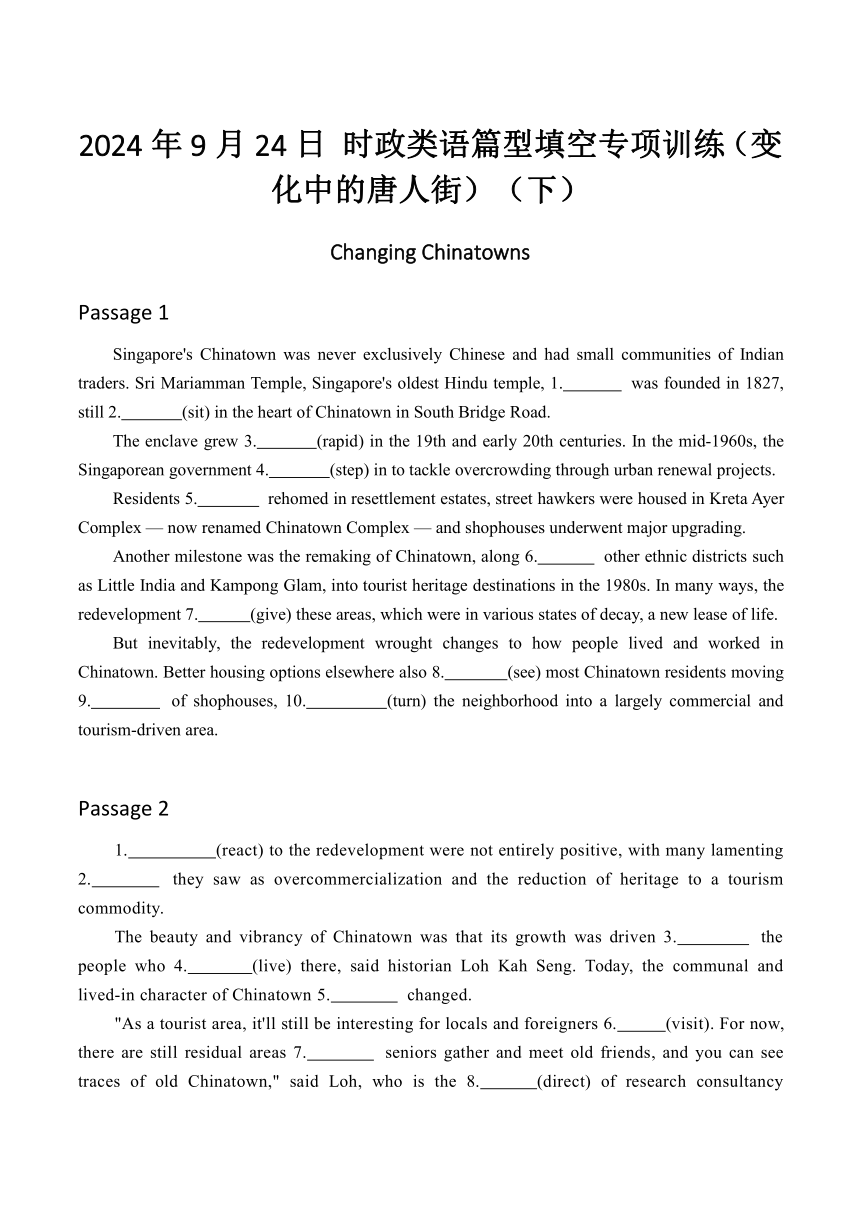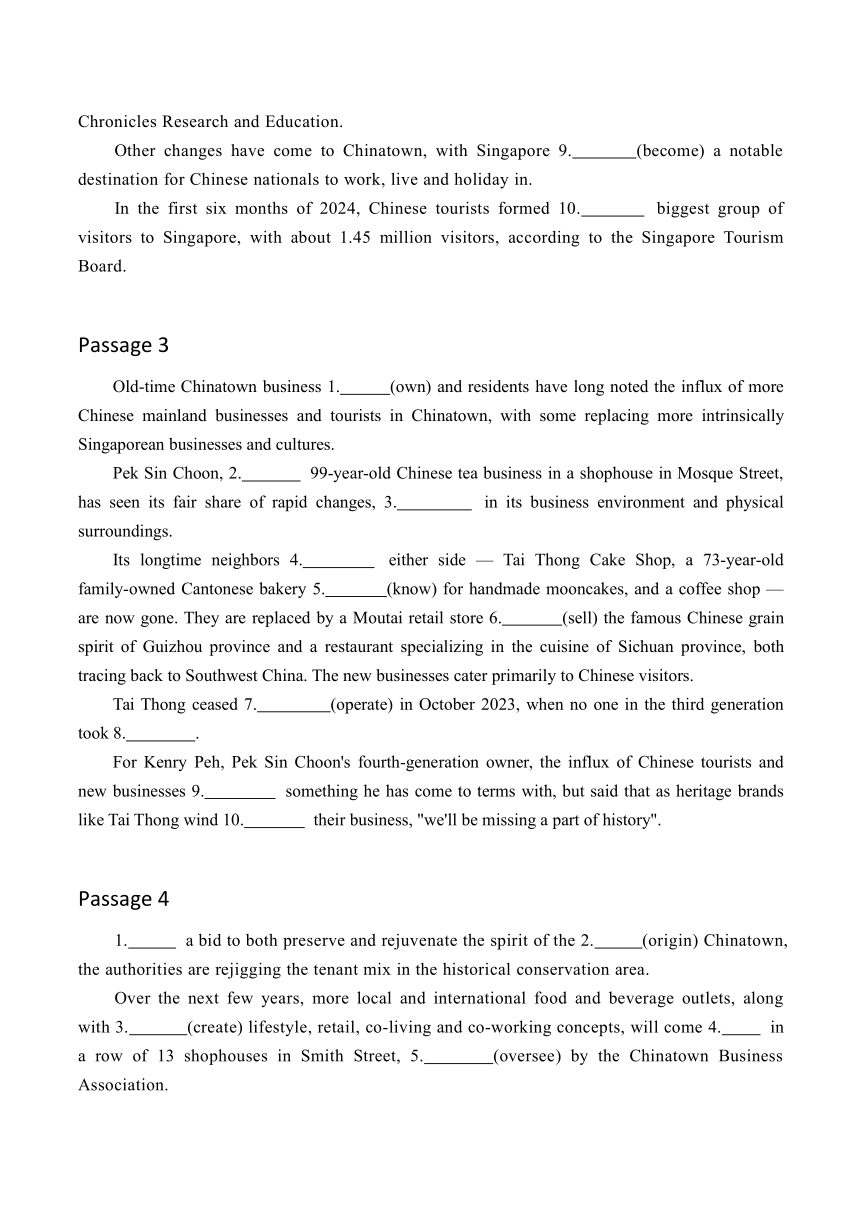2024年9月24日+时政类语篇型填空专项训练(变化中的唐人街)(下)(4篇,含答案与译文)-2025届高三英语二轮复习专项
文档属性
| 名称 | 2024年9月24日+时政类语篇型填空专项训练(变化中的唐人街)(下)(4篇,含答案与译文)-2025届高三英语二轮复习专项 |  | |
| 格式 | docx | ||
| 文件大小 | 29.1KB | ||
| 资源类型 | 教案 | ||
| 版本资源 | 人教版(2019) | ||
| 科目 | 英语 | ||
| 更新时间 | 2025-01-15 13:54:53 | ||
图片预览


文档简介
2024年9月24日 时政类语篇型填空专项训练(变化中的唐人街)(下)
Changing Chinatowns
Passage 1
Singapore's Chinatown was never exclusively Chinese and had small communities of Indian traders. Sri Mariamman Temple, Singapore's oldest Hindu temple, 1. was founded in 1827, still 2. (sit) in the heart of Chinatown in South Bridge Road.
The enclave grew 3. (rapid) in the 19th and early 20th centuries. In the mid-1960s, the Singaporean government 4. (step) in to tackle overcrowding through urban renewal projects.
Residents 5. rehomed in resettlement estates, street hawkers were housed in Kreta Ayer Complex — now renamed Chinatown Complex — and shophouses underwent major upgrading.
Another milestone was the remaking of Chinatown, along 6. other ethnic districts such as Little India and Kampong Glam, into tourist heritage destinations in the 1980s. In many ways, the redevelopment 7. (give) these areas, which were in various states of decay, a new lease of life.
But inevitably, the redevelopment wrought changes to how people lived and worked in Chinatown. Better housing options elsewhere also 8. (see) most Chinatown residents moving 9. of shophouses, 10. (turn) the neighborhood into a largely commercial and tourism-driven area.
Passage 2
1. (react) to the redevelopment were not entirely positive, with many lamenting 2. they saw as overcommercialization and the reduction of heritage to a tourism commodity.
The beauty and vibrancy of Chinatown was that its growth was driven 3. the people who 4. (live) there, said historian Loh Kah Seng. Today, the communal and lived-in character of Chinatown 5. changed.
"As a tourist area, it'll still be interesting for locals and foreigners 6. (visit). For now, there are still residual areas 7. seniors gather and meet old friends, and you can see traces of old Chinatown," said Loh, who is the 8. (direct) of research consultancy Chronicles Research and Education.
Other changes have come to Chinatown, with Singapore 9. (become) a notable destination for Chinese nationals to work, live and holiday in.
In the first six months of 2024, Chinese tourists formed 10. biggest group of visitors to Singapore, with about 1.45 million visitors, according to the Singapore Tourism Board.
Passage 3
Old-time Chinatown business 1. (own) and residents have long noted the influx of more Chinese mainland businesses and tourists in Chinatown, with some replacing more intrinsically Singaporean businesses and cultures.
Pek Sin Choon, 2. 99-year-old Chinese tea business in a shophouse in Mosque Street, has seen its fair share of rapid changes, 3. in its business environment and physical surroundings.
Its longtime neighbors 4. either side — Tai Thong Cake Shop, a 73-year-old family-owned Cantonese bakery 5. (know) for handmade mooncakes, and a coffee shop — are now gone. They are replaced by a Moutai retail store 6. (sell) the famous Chinese grain spirit of Guizhou province and a restaurant specializing in the cuisine of Sichuan province, both tracing back to Southwest China. The new businesses cater primarily to Chinese visitors.
Tai Thong ceased 7. (operate) in October 2023, when no one in the third generation took 8. .
For Kenry Peh, Pek Sin Choon's fourth-generation owner, the influx of Chinese tourists and new businesses 9. something he has come to terms with, but said that as heritage brands like Tai Thong wind 10. their business, "we'll be missing a part of history".
Passage 4
1. a bid to both preserve and rejuvenate the spirit of the 2. (origin) Chinatown, the authorities are rejigging the tenant mix in the historical conservation area.
Over the next few years, more local and international food and beverage outlets, along with 3. (create) lifestyle, retail, co-living and co-working concepts, will come 4. in a row of 13 shophouses in Smith Street, 5. (oversee) by the Chinatown Business Association.
As the Chinese left their homeland and moved to different parts of 6. world, they found their community and created a space where they 7. (feel) they belonged.
Today, Chinatowns 8. put their stamp on many parts of Asia and while some have disappeared and 9. evolved, they still provide a tangible link for locals and visitors alike to a Chinese culture 10. has lasted centuries.
参考答案
参考答案1
1.which 2.sits 3.rapidly 4.stepped 5.were
6.with 7.gave 8.saw 9.out 10.turning
参考译文1
新加坡的唐人街从来都不是华人的聚集地,也有小规模的印度商人聚居区。马里安曼兴都庙是新加坡最古老的印度教寺庙,始建于 1827 年,至今仍坐落在桥南路唐人街的中心地带。
19 世纪和 20 世纪初,这片区域发展迅速。20 世纪 60 年代中期,新加坡政府开始通过城市更新项目解决人口过剩问题。
居民被安置在安置区,街头小贩被安置在牛车水综合大楼(现已更名为牛车水综合大楼),店屋也进行了大规模的升级改造。
另一个里程碑是 1980 年代将唐人街以及小印度和甘榜格南等其他民族区改造成旅游遗产目的地。从许多方面来看,重建使这些处于不同程度衰败状态的地区焕发了新的生机。
但重建不可避免地改变了唐人街居民的生活和工作方式。其他地方住房条件的改善也导致大多数唐人街居民搬离店屋,使该社区变成了一个以商业和旅游业为主的地区。
参考答案2
1.Reactions 2.what 3.by 4.lived 5.has
6.to visit 7.where 8.director 9.becoming 10.the
参考译文2
人们对重建的反应并不完全是积极的,许多人抱怨称,他们看到了过度商业化,文化遗产沦为旅游商品。
历史学家罗家成说,唐人街的美丽和活力源于其发展是由居住在那里的人们推动的。如今,唐人街的社区和居住特征已经发生了变化。
“作为旅游区,它对当地人和外国人来说仍然很有趣。目前,这里仍然有一些老年人聚会和会见老朋友的残留区域,你可以看到老唐人街的痕迹,”研究咨询公司 Chronicles Research and Education 的主管 Loh 说道。
唐人街也发生了其他变化,新加坡成为华人工作、生活和度假的著名目的地。
据新加坡旅游局称,2024年上半年,中国游客成为新加坡最大的游客群体,约有145万人次。
参考答案3
1.owners 2.a 3.both 4.on 5.known
6.selling 7.operations 8.over 9.is 10.up
参考译文3
老唐人街的企业主和居民早就注意到,越来越多的中国大陆企业和游客涌入唐人街,其中一些企业和文化甚至取代了更具新加坡特色的企业和文化。
白新春茶庄位于摩士庙街的一栋店屋内,已有 99 年历史。无论其商业环境还是物质环境,都经历了快速的变化。
两边的老邻居——大同饼家(一家拥有 73 年历史的家族经营的广式面包店,以手工月饼闻名)和一家咖啡店——现在已经不复存在。取而代之的是一家销售中国贵州省著名谷物白酒的茅台酒零售店和一家专营四川菜的餐馆,这两家店的历史都可以追溯到中国西南地区。这些新店主要面向中国游客。
2023年10月,大同集团停止运营,第三代继承人无人接手。
对于白新春饭店第四代掌舵人 Kenry Peh 来说,他已经接受了中国游客和新企业的涌入,但他表示,随着大同等老牌品牌结束业务,“我们会错过一部分历史”。
参考答案4
1.In 2.original 3.creative 4.up 5.overseen
6.the 7.felt 8.have 9.others 10.that
参考译文4
为了保护和振兴原有唐人街的精神,当局正在重新调整历史保护区内的租户结构。
未来几年,在唐人街商业协会的监管下,史密斯街的 13 栋店屋将陆续建成更多本地和国际餐饮店面,以及创意生活方式、零售、共享生活和共享工作理念。
当华人离开故土,移居到世界各地时,他们找到了自己的社区,并创造了一个让他们感到归属的空间。
如今,唐人街已在亚洲许多地区留下了自己的印记。尽管有些唐人街已经消失,有些则不断发展,但它们仍然为当地人和游客提供了与延续数百年的中国文化的切实纽带。
Changing Chinatowns
Passage 1
Singapore's Chinatown was never exclusively Chinese and had small communities of Indian traders. Sri Mariamman Temple, Singapore's oldest Hindu temple, 1. was founded in 1827, still 2. (sit) in the heart of Chinatown in South Bridge Road.
The enclave grew 3. (rapid) in the 19th and early 20th centuries. In the mid-1960s, the Singaporean government 4. (step) in to tackle overcrowding through urban renewal projects.
Residents 5. rehomed in resettlement estates, street hawkers were housed in Kreta Ayer Complex — now renamed Chinatown Complex — and shophouses underwent major upgrading.
Another milestone was the remaking of Chinatown, along 6. other ethnic districts such as Little India and Kampong Glam, into tourist heritage destinations in the 1980s. In many ways, the redevelopment 7. (give) these areas, which were in various states of decay, a new lease of life.
But inevitably, the redevelopment wrought changes to how people lived and worked in Chinatown. Better housing options elsewhere also 8. (see) most Chinatown residents moving 9. of shophouses, 10. (turn) the neighborhood into a largely commercial and tourism-driven area.
Passage 2
1. (react) to the redevelopment were not entirely positive, with many lamenting 2. they saw as overcommercialization and the reduction of heritage to a tourism commodity.
The beauty and vibrancy of Chinatown was that its growth was driven 3. the people who 4. (live) there, said historian Loh Kah Seng. Today, the communal and lived-in character of Chinatown 5. changed.
"As a tourist area, it'll still be interesting for locals and foreigners 6. (visit). For now, there are still residual areas 7. seniors gather and meet old friends, and you can see traces of old Chinatown," said Loh, who is the 8. (direct) of research consultancy Chronicles Research and Education.
Other changes have come to Chinatown, with Singapore 9. (become) a notable destination for Chinese nationals to work, live and holiday in.
In the first six months of 2024, Chinese tourists formed 10. biggest group of visitors to Singapore, with about 1.45 million visitors, according to the Singapore Tourism Board.
Passage 3
Old-time Chinatown business 1. (own) and residents have long noted the influx of more Chinese mainland businesses and tourists in Chinatown, with some replacing more intrinsically Singaporean businesses and cultures.
Pek Sin Choon, 2. 99-year-old Chinese tea business in a shophouse in Mosque Street, has seen its fair share of rapid changes, 3. in its business environment and physical surroundings.
Its longtime neighbors 4. either side — Tai Thong Cake Shop, a 73-year-old family-owned Cantonese bakery 5. (know) for handmade mooncakes, and a coffee shop — are now gone. They are replaced by a Moutai retail store 6. (sell) the famous Chinese grain spirit of Guizhou province and a restaurant specializing in the cuisine of Sichuan province, both tracing back to Southwest China. The new businesses cater primarily to Chinese visitors.
Tai Thong ceased 7. (operate) in October 2023, when no one in the third generation took 8. .
For Kenry Peh, Pek Sin Choon's fourth-generation owner, the influx of Chinese tourists and new businesses 9. something he has come to terms with, but said that as heritage brands like Tai Thong wind 10. their business, "we'll be missing a part of history".
Passage 4
1. a bid to both preserve and rejuvenate the spirit of the 2. (origin) Chinatown, the authorities are rejigging the tenant mix in the historical conservation area.
Over the next few years, more local and international food and beverage outlets, along with 3. (create) lifestyle, retail, co-living and co-working concepts, will come 4. in a row of 13 shophouses in Smith Street, 5. (oversee) by the Chinatown Business Association.
As the Chinese left their homeland and moved to different parts of 6. world, they found their community and created a space where they 7. (feel) they belonged.
Today, Chinatowns 8. put their stamp on many parts of Asia and while some have disappeared and 9. evolved, they still provide a tangible link for locals and visitors alike to a Chinese culture 10. has lasted centuries.
参考答案
参考答案1
1.which 2.sits 3.rapidly 4.stepped 5.were
6.with 7.gave 8.saw 9.out 10.turning
参考译文1
新加坡的唐人街从来都不是华人的聚集地,也有小规模的印度商人聚居区。马里安曼兴都庙是新加坡最古老的印度教寺庙,始建于 1827 年,至今仍坐落在桥南路唐人街的中心地带。
19 世纪和 20 世纪初,这片区域发展迅速。20 世纪 60 年代中期,新加坡政府开始通过城市更新项目解决人口过剩问题。
居民被安置在安置区,街头小贩被安置在牛车水综合大楼(现已更名为牛车水综合大楼),店屋也进行了大规模的升级改造。
另一个里程碑是 1980 年代将唐人街以及小印度和甘榜格南等其他民族区改造成旅游遗产目的地。从许多方面来看,重建使这些处于不同程度衰败状态的地区焕发了新的生机。
但重建不可避免地改变了唐人街居民的生活和工作方式。其他地方住房条件的改善也导致大多数唐人街居民搬离店屋,使该社区变成了一个以商业和旅游业为主的地区。
参考答案2
1.Reactions 2.what 3.by 4.lived 5.has
6.to visit 7.where 8.director 9.becoming 10.the
参考译文2
人们对重建的反应并不完全是积极的,许多人抱怨称,他们看到了过度商业化,文化遗产沦为旅游商品。
历史学家罗家成说,唐人街的美丽和活力源于其发展是由居住在那里的人们推动的。如今,唐人街的社区和居住特征已经发生了变化。
“作为旅游区,它对当地人和外国人来说仍然很有趣。目前,这里仍然有一些老年人聚会和会见老朋友的残留区域,你可以看到老唐人街的痕迹,”研究咨询公司 Chronicles Research and Education 的主管 Loh 说道。
唐人街也发生了其他变化,新加坡成为华人工作、生活和度假的著名目的地。
据新加坡旅游局称,2024年上半年,中国游客成为新加坡最大的游客群体,约有145万人次。
参考答案3
1.owners 2.a 3.both 4.on 5.known
6.selling 7.operations 8.over 9.is 10.up
参考译文3
老唐人街的企业主和居民早就注意到,越来越多的中国大陆企业和游客涌入唐人街,其中一些企业和文化甚至取代了更具新加坡特色的企业和文化。
白新春茶庄位于摩士庙街的一栋店屋内,已有 99 年历史。无论其商业环境还是物质环境,都经历了快速的变化。
两边的老邻居——大同饼家(一家拥有 73 年历史的家族经营的广式面包店,以手工月饼闻名)和一家咖啡店——现在已经不复存在。取而代之的是一家销售中国贵州省著名谷物白酒的茅台酒零售店和一家专营四川菜的餐馆,这两家店的历史都可以追溯到中国西南地区。这些新店主要面向中国游客。
2023年10月,大同集团停止运营,第三代继承人无人接手。
对于白新春饭店第四代掌舵人 Kenry Peh 来说,他已经接受了中国游客和新企业的涌入,但他表示,随着大同等老牌品牌结束业务,“我们会错过一部分历史”。
参考答案4
1.In 2.original 3.creative 4.up 5.overseen
6.the 7.felt 8.have 9.others 10.that
参考译文4
为了保护和振兴原有唐人街的精神,当局正在重新调整历史保护区内的租户结构。
未来几年,在唐人街商业协会的监管下,史密斯街的 13 栋店屋将陆续建成更多本地和国际餐饮店面,以及创意生活方式、零售、共享生活和共享工作理念。
当华人离开故土,移居到世界各地时,他们找到了自己的社区,并创造了一个让他们感到归属的空间。
如今,唐人街已在亚洲许多地区留下了自己的印记。尽管有些唐人街已经消失,有些则不断发展,但它们仍然为当地人和游客提供了与延续数百年的中国文化的切实纽带。
